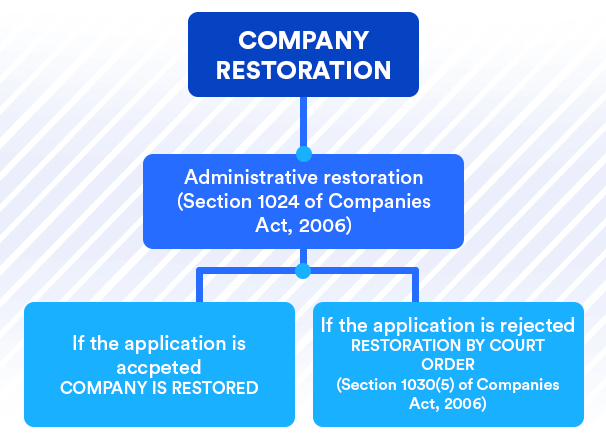
Does the dissolution of a company put an end to the company’s existence? What if a company is dissolved against the wishes of members and there is a need to restore it for reasons such as paying debts, continue trading, realise assets for members, etc. Is there any way of restoring a dissolved company? Is there any lapse of time regulations for getting a company back on its feet? We are going to unfold the process of company restoration to make it as clear as possible:

There are two well-known ways of restoring a dissolved company as can be seen from the diagram above. Let us begin with understanding the administrative restoration first.
ADMINISTRATIVE RESTORATION
Application
The application for company restoration under administrative procedure needs to be made in form RT01. It requires some basic details like company name and number, statement of compliance, alternative company name, etc. Furthermore, it needs to be accompanied by fees of £100.
Conditions to apply for administrative restoration
The application under this procedure can be made only if:
- The company’s name was struck off the register of companies as it appeared to be defunct. For instance, failure to submit confirmation statements and/or accounts or not responding to reminders from HMRC and Companies House, etc.
- The application is made by a former member or a director.
- The application is made within 6 years from the date of dissolution.
Pre-conditions for restoration
The registrar will consider restoring the dissolved company only if the following conditions are met:
- The application RT01 Form should be a valid one, i.e., it satisfies all the conditions above
- The company should be carrying on business at the time of dissolution.
- The Crown should signify its consent in writing for the restoration of the company through a bona vacantia waiver letter. This waiver letter also confirms that the Treasury Solicitor shall release any assets held by the Crown back to the company, upon restoration.
- All the outstanding documents at the date of the dissolution of the company and those that have fallen due since then need to be submitted to Companies House so that all the current and up-to-date information about the company is updated in the records.
- Penalties due to be paid for non-filing or late filing of accounts Late filing penalties that were due to be paid at the time of dissolution need to be paid off. The maximum amount of penalty could be £1,500 for a single set of accounts and shall multiply with multiple sets of accounts that were overdue.
The vital point here is that the Companies House does not charge a penalty for the period between dissolution and application for company restoration made. Thus, if accounts were overdue for example 7 months at the time of dissolution, they will be treated as 7 months late, even if several years have elapsed since the company’s dissolution.
Statement of Compliance
As indicated on RT01 (Application form for administrative registration) the person making the statement has the standing to apply for restoration and that all the requirements of administrative restoration have been met.
Processing of application
Once all the formalities have been complied with, the restoration team begins processing the application. If Companies House decides to restore the company, the restoration takes effect from the date notice is sent. But if the application is rejected then it can be taken up for restoration by court order.
RESTORATION BY COURT ORDER
Conditions to apply for restoration by court order
The application under this procedure may be:
- To bring proceedings against the company for damages for personal injury
- To bring proceedings by the insurer against a third party in the name of that company in respect of that company’s liability for damages for personal injury. To bring proceedings against the company for damages for personal injury
- The company’s name was struck off the register of companies as it appeared to be defunct. So an application for administrative restoration was made to Companies House within the time allowed for making such an application, i.e. 6 years from the dissolution, and the registrar had refused the application.
- Where a person wishes to apply for restoration of the company but none of the conditions for administrative restoration is fulfilled, then he/she can resort to applying for restoration through a court order. For example, if the creditor of the company or any person with a potential legal claim against the company requires the company to be restored for settling their debts then they can also apply for the restoration of the company by court order.
The time period for applying for restoration of a company by court order
If the case falls under conditions 1 and 2 stated above, then the application may be made at any time even if 6 years have elapsed.
If the case falls under condition 3 above then the application for a court order for company restoration may be made within 28 days of notice of the registrar's decision being issued by the registrar, even if the period of 6 years has expired.
In any other case, the application shall be made within 6 years of the original dissolution of the company.
The effect upon the restoration
- The company shall be deemed to have continued in existence as if it had not been dissolved or struck off the register.
- No liability to pay non-filing penalties for the period between dissolution to the application for the restoration of the company.
- The court may give directions or make provisions to place the company and all other persons in the same position as they were before the dissolution. In case of administrative restoration, the company can also apply to the court for giving such directions or making such provisions within a period of 3 years from the restoration.
Company’s name upon restoration
A company shall be restored to register with the name it had before its dissolution. However, there could be a chance that another company might have commenced its business with the same or similar name while the company was dissolved. In such a case company cannot work with its previous name. It will need to restore under a unique name. In case of administrative restoration, the company can give its alternative name in form RT01, and in case of restoration by court order, in the application, it submits to court. And if no alternative name is suggested in these applications then the company is restored with its registered number as if it was its name.
If the company is restored with a registered number as its name then the company shall decide its name with the consent of directors and inform ROC within 14 days of restoration.
Conclusion:
The process of restoring a dissolved company entails payment of penalties, filing fees, application fees, etc. which at times make the restoration of the company a costly affair. So, it’s important to weigh the costs involved in the restoration process with the benefits that the company can reap from the restoration. You should consider taking up the restoration process only if it seems to be a viable option. We strongly recommend consulting an expert before taking any action. You can also Contact US for assistance regarding restoring your company.
Company restoration service
View Package











